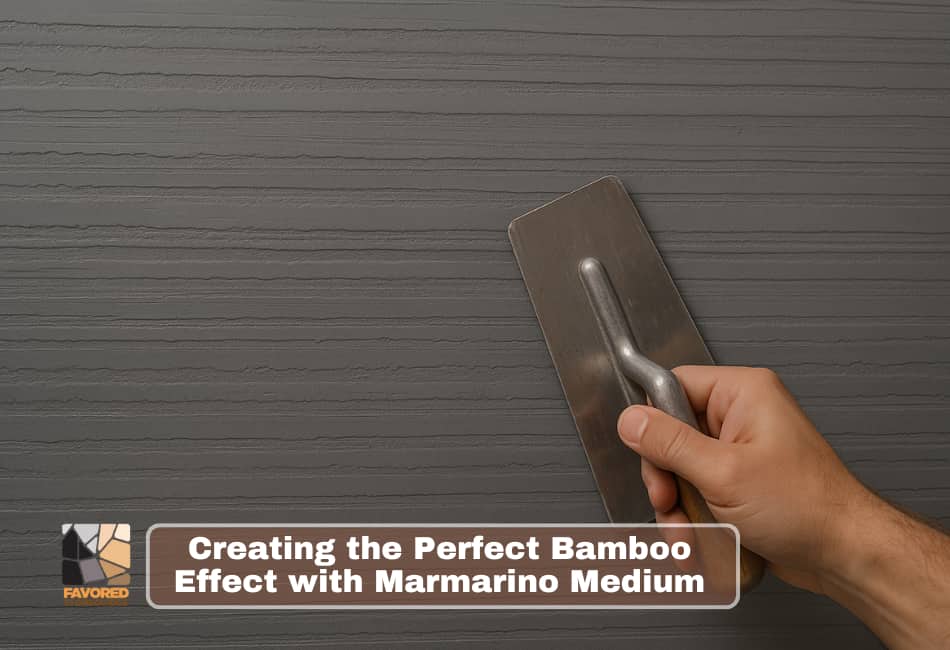The bamboo effect using Marmarino Medium is a stunning plaster finish that brings natural texture, depth, and warmth to any wall or large surface.
Perfect for accent walls or feature panels, this finish blends artisan craftsmanship with organic beauty.
This guide walks you through the process step by step, from surface preparation to waxing, whether you are working on a small sample or an expansive wall.
1. Preparing the Wall
Before you begin, ensure the wall or working surface is:
- Clean and dust-free
- Smooth, dry, and structurally sound
Apply a quartz primer to promote adhesion. Use a roller for large areas or a brush for corners and edges. Allow the primer to dry overnight or as recommended by the manufacturer.
The quartz primer provides a lightly textured base, ideal for the Marmarino Medium to bond effectively.
2. Applying the Base Coat
The base coat builds the foundation for the bamboo effect.
Materials needed:
- Marmarino Medium (pre-mixed with your chosen ink color, such as 027-1)
- Stainless steel trowel
- Spatula or mixing tool
- Clean water
- Larger plastering trowel (optional for large walls)
Steps:
- Load your trowel with Marmarino Medium using the spatula.
- Hold the trowel at a shallow angle, below 20 degrees.
- Apply the plaster in horizontal strokes, covering the entire wall evenly.
- Work left to right if you are right-handed, or right to left if left-handed.
- Apply a slightly thicker coat to build texture.
- Smooth out excessive ridges but do not overwork the plaster.
Allow the base coat to dry for at least 12 hours or overnight. For large surfaces, a larger plastering trowel can be used to speed up coverage.
If the trowel feels stuck during application, slide it gently until it releases rather than pulling it directly off the wall.
3. Applying the Top Coat
The top coat adds depth and prepares the surface for the bamboo texture.
Steps:
- Mix your Marmarino Medium thoroughly before use.
- Apply the top coat in horizontal strokes using a shallow trowel angle (below 20 degrees).
- Ensure complete coverage over the base coat.
- Smooth any excess without fully flattening the surface.
- Monitor the drying process carefully; the goal is for the plaster to reach 50–60% dryness before creating the bamboo effect. This typically takes 5–10 minutes on small areas or up to 30 minutes on large walls, depending on room temperature.
4. Creating the Bamboo Texture
Once the surface is partially dry and firm yet workable, it is time to create the bamboo texture.
Materials needed:
- Bamboo trowel
Steps:
- Start where you first applied the top coat.
- Drag the bamboo trowel horizontally across the surface.
- Apply consistent, firm pressure to create the bamboo-like grooves.
- Continue section by section, overlapping slightly for a seamless pattern.
For large surfaces, work in 1-meter sections to maintain control over drying times. You can also have a second person assist, with one applying plaster and the other following with the bamboo trowel.
5. Burnishing the Bamboo Finish
Burnishing enhances the tactile quality without creating a high gloss.
Steps:
- Wait until the surface is 50–60% dry (firm but not fully hardened).
- Lightly glide a clean stainless steel trowel over the textured surface.
- Use very gentle pressure to smooth high spots without flattening the grooves.
- You should be able to hold the trowel with two fingers to achieve the ideal pressure.
- Burnish each section for 2–3 minutes, just enough to harden the material.
- Avoid prolonged burnishing; the bamboo finish is meant to have a matte, natural appearance.
Allow the surface to dry completely for at least 12 hours before waxing.
6. Waxing the Bamboo Effect
Waxing adds a protective layer and enhances subtle tonal variations.
Materials needed:
- Natural beeswax
- Pinello brush or sponge
- Microfiber cloth
Steps:
- Shake the beeswax well before use.
- Apply an even coat using a brush or sponge, following the same direction as the bamboo trowel lines to ensure wax penetrates the grooves.
- Let the wax soak for 5–10 minutes on small surfaces or 30–60 minutes on large walls.
- Polish with a microfiber cloth, following the same directional pattern.
- Turn the cloth regularly to avoid reapplying excess wax.
For extra durability, apply a second coat of beeswax after the first coat dries.
If desired, you can substitute the second coat with black wax or bronze pearl cream to introduce subtle color variations.
Waxing Large Surfaces
When waxing large walls:
- Use a larger brush or sponge for faster coverage.
- Polish by hand to ensure wax is removed from deep grooves.
- Optionally, use a machine polisher with a microfiber bonnet to speed up the process.
Allow the wall to cure overnight before exposing it to moisture or wear.
Final Thoughts
The bamboo effect with Marmarino Medium is a refined, organic finish that transforms plain walls into elegant, textured surfaces.
Its tactile warmth makes it ideal for contemporary interiors, spas, or feature walls seeking a natural yet sophisticated aesthetic.
With careful timing, thoughtful application, and attention to detail, you can create a truly unique finish that elevates any space.

